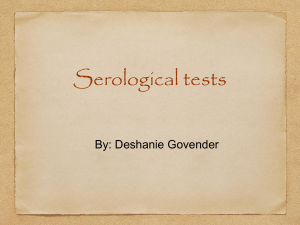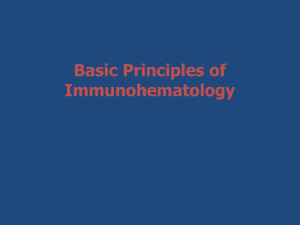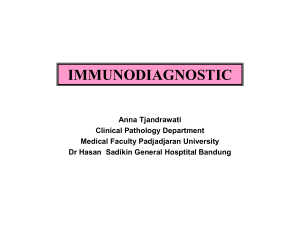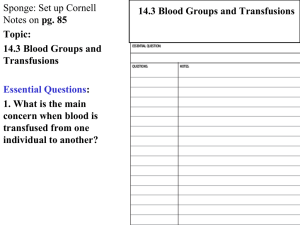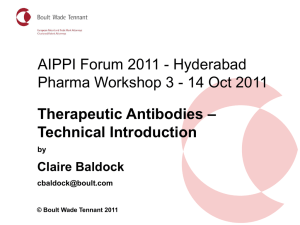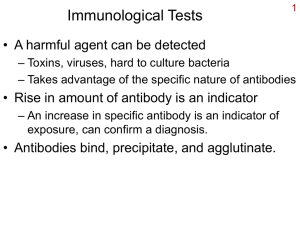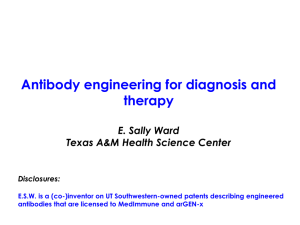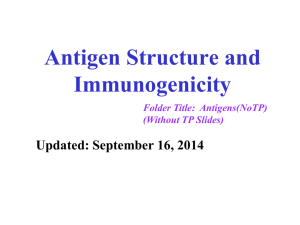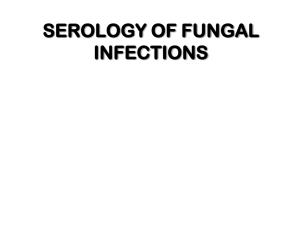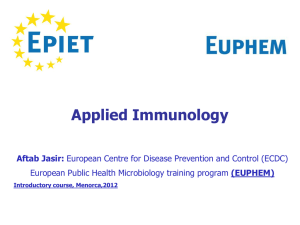Basic Principles of Immunology and Ag
advertisement
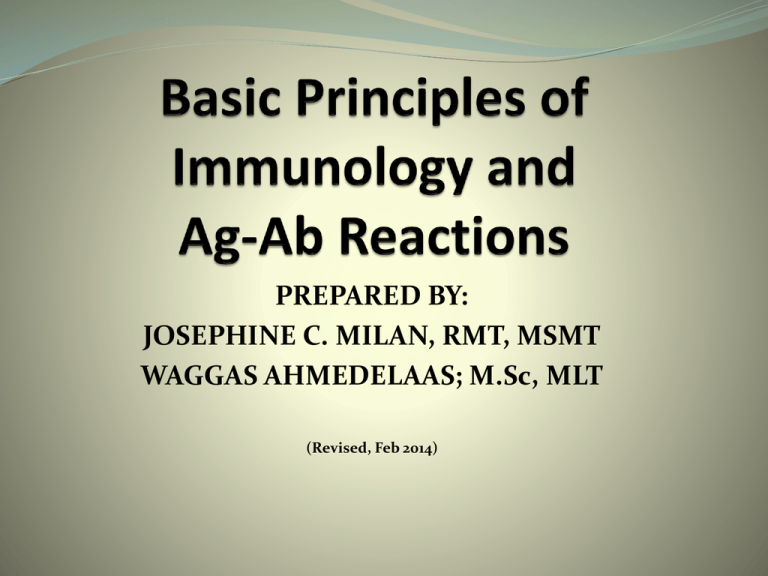
PREPARED BY: JOSEPHINE C. MILAN, RMT, MSMT WAGGAS AHMEDELAAS; M.Sc, MLT (Revised, Feb 2014) Objective and Focus To recall basic concepts of Immunology and Antigen- Antibody reactions as they apply to Blood Banking practice, such as: Immune response arising from blood group antigen stimulation Characteristics of antigens Describing clinically significant antibodies Enhancing Ag-Ab reactions Topic Outline Definition and properties of Antigen, immunogen Definition and properties, types of antibodies The immune system response in relation to Immunohematology or blood banking practice Nature/ principle of Ag-Ab reactions ANTIGEN, IMMUNOGEN ANTIGEN (Ag)– substance recognized as foreign by the body, which when introduced to a host , will stimulate an immune response. Immune response 1. activation of the cellular components of immune system 2. the production of specific antibodies Properties of antigen: 1. Specific reactivity – react with specific antibody 2. Immunogenicity- stimulate immune response Blood Group Antigens Biochemically : Protein, large polysaccharide, glycoproteins or glycolipids Immunogenic, antigenic Represent the blood group phenotype Determined by blood group genes Antigens are integral structural component of the RBC membrane BLOOD GROUP ANTIBODIES Gamma globulins / immunogloblins Produced in response to antigenic stimulation. How? Exposure through pregnancy Exposure through transfusion Exposure through transplant Essentially of Ig M and IgG classes; some IgA Characterized with specific reaction with blood group antigen epitopes/ determinants Antibodies: Produced and secreted by activated B lymphocytes (plasma cells) Types: 1. Heteroantibodies (xenoantibodies) – produced in response to antigens from another species. 2. Alloantibodies / isoantibodies – produced in response to antigens from individuals of the same species; such as those involved in transfusion reactions 3. Autoantibodies – made in response to the body’s own antigens. Ig CLASSES OF SOME BLOOD GROUP ANTIBODIES IgM antibodies important in Blood banking includes those against : ABH, Ii, MN, Lewis, Lutheran, and P. IgG antibodies important in Blood banking includes those against: Rh(D), Ss, Kell, Duffy, and Kidd. IgA antibodies – Le, ABH subs II. Antibody Classes IgM IgG IgA IgD IgE Other names Macroglobulin - Secretory Ig - Reagin % 5-10 75 – 85 5-15 0.001 0.0003 MW 900,000 150,000 160,000 & 400,000 180,000 190,000 Half-life 9 - 11d 25 - 35d 6-8d 2-3d 2d 56 C stable yes yes yes no no Pass thru placenta no yes no no No valence 10 2 2,4 2 2 C-fixing yes IgG3 No no no subclass 2 4 2 - - form pentamer monomer dimer Monomer Monomer Ig G structure Ig M structure Secretory Ig A Serologic properties of Abs: IgM Strong agglutinins (3-4+ agglutination) Reactive at cold temperature (4 0C to room temp) React to cells suspended in saline Fix/ activate the complement IgG Weak agglutinins, need AHG Reactive at warm temperature (37 oC) React to red cells in protein or potentiating medium Weakly activate the complement ANTIBODY FUNCTIONS Primary function: to bind with antigen Secondary functions/ biological effector functions: Complement fixation/ activation hemolysis of red cells Placental transfer ( Ig G) Bind on receptor sites on tissues and other cells The Complement in Immunohematology Proteins normally produced in the body. Unstable, heat labile (56 oC); serum must be fresh When activated, they cause lysis of cell membrane of antibody-coated RBCs. Complement is activated by the classic pathway : IgM or IgG3 antibodies bound to red cell antigens C1 component binds to the Fc portion of the Ab activate C4, C2, C3, C5, C6 + C7 + C8 + C9 lysis. Reason why: hemolysis of RC is a positive result. IMMUNE RESPONSE Immune system – activated by the presence of foreign antigen, or abnormal autoantigen. Cells involved : APCs (antigen presenting cells)= macrophages, dendritic cells, monocytes Lymphocytes = T helper, T cytotoxic, B/ plasma cells Natural killer, neutrophils, eosinophils, basophils, platelets Plasma cells; Monocytes; Neutrophols; Platelets; Lymphocytes IMMUNE RESPONSES in Immunohematology 1. antibody production IgM and IgG 2. hemolytic reaction mediated by Ab-Ag and complement (cascade pathway) 3. inflammatory reaction tissue necrosis (organ transplantation) 4. allergic reaction mediated by IgE with basophils and mast cells IMMUNE RESPONSE BY BLOOD GROUP ANTIGEN STIMULATION PREGNANCY – incompatible blood type of fetus to that of mother (baby’s antigen foreign to the mother) E.g. Baby is D(+), mother is D(-) TRANSFUSION- incompatible blood type between patient (recipient) and donor blood Tissue/ organ transplantation – incompatible type between patient (recipient) and donor tissue PRINCIPLES OF ANTIGEN- ANTIBODY REACTION MANIFESTATIONS OF ANTIGEN – ANTIBODY REACTION 1. Red cell agglutination Clumping of red cells Various grades of strength of reaction (4+, 3+, 2+, 1+, +/-) 2. Hemolysis (red cell destructionHb) Red tinge of supernatant Minimal red cell button or none at all May be misread as negative Grades of agglutination reaction NON- SPECIFIC AGGREGATION OF RED CELLS; NOT (+) RESULT Rouleaux Formation Stacked-coin formation Found in patients with Multiple Myeloma, Walderstrom’s Macroglobulinemia or Hyperviscosity Syndrome The red cells cluster and resembles a macroscopic agglutination) NATURE OF Ag- Ab REACTIONS A. Lock and Key principle specific reaction of antigen and antibody the antigenic determinant fit in a cleft / space formed by the combining site of the antibody (at the Fab region, formed by variable regions of light and heavy chains) Ag-Ab binding NATURE OF Ag – Ab REACTIONS B. Non-covalent Bonds That hold the Ag in the antibody combining site Include hydrogen bonds, electrostatic bonds, Van der Waals forces and hydrophobic bonds Multiple bonding ensures the Ag bound to the Ab is tight and stable. STAGES OF RED CELL AGGLUTINATION 1. PRIMARY STAGE ( ANTIBODY SENSITIZATION) Involves binding of the paratope /combining site of the Ab and the epitope/ determinant of the Ag in a reversible reaction). 2. SECONDARY STAGE OF RED CELL AGGLUTINATION : LATTICE FORMATION Multiple erythrocytes with bound antibodies form a latticework through Ag--Ab bridges formed between adjacent erythrocytes The lattice formed is the basis of all visible agglutination reactions. FACTORS AFFECTING THE PRIMARY STAGE OF REACTION 1. Temperature The nature of the bonds determines if the reaction occurs better at colder or warmer temperature. With hydrogen bonds- they are exothermic, reaction occurs better at colder temperature Associated with carbohydrates antigen e.g. ABH, Lewis, P1, I) FACTORS AFFECTING THE PRIMARY STAGE OF REACTION If with hydrophobic bonding, the reaction is optimally reactive at body temperature, 37 OC This type of bond is normally associated with protein antigen e.g. Rh, Kell, Duffy FACTORS AFFECTING THE PRIMARY STAGE OF REACTION 2. Effect Of pH Optimum pH for most antigen-antibody reactions = 6.5 to 7.5 Some antigens show stronger reactivity at lower pH e.g. anti-M, and anti-D at pH 6.5 – 7.0 FACTORS AFFECTING THE PRIMARY STAGE OF REACTION 3. Ionic Strength refers to charge concentration of the suspending (reaction) medium. decreasing the ionic strength of the suspending medium reduces the interfering effects of the electrostatic barrier… THUS, better attraction between antigen and antibody. FACTORS AFFECTING THE PRIMARY STAGE OF REACTION Low Ionic Strength Saline (LISS) Consists of 0.2 % NaCl Bring about increased rate of antibody uptake for the Ag during sensitization shortens incubation period of 15 to 5 minutes. FACTORS AFFECTING THE PRIMARY STAGE OF REACTION 4. Time of Incubation To allow antigen/antibody reactions reach equilibrium 15 to 60 minutes FACTORS AFFECTING THE PRIMARY STAGE OF REACTION 5. Effect Of Antigen-antibody Ratio Amounts of antigen and antibody should be in optimal proportions Optimum ratio is 80 parts antibody to 1 part antigen 2 drops serum : 1 drop RCS Excess in either antigen or antibody results to non occurrence of lattice formation leading to a false-negative result. FACTORS AFFECTING THE PRIMARY STAGE OF REACTION FACTORS AFFECTING THE SECONDARY STAGE 1. ZETA POTANTIAL The surface of red cells carry a negative charge . In saline, red cells will attract positively charged Na+, and an ionic cloud will form around each cell. Thus the cells repel each other and stay a certain distance apart. ZETA POTENTIAL • IgG antibodies cannot cause agglutination when zeta potential exists. • To overcome zeta potential techniques are needed to neutralize these charges. FACTORS AFFECTING THE SECONDARY STAGE 2. Effect of Centrifugation The antibody - sensitized red cells are subjected to high gravitational force to overcome the natural repulsive effect of the red cells to one another Closer physical proximity (nearness) increases antigen-antibody bridging FACTORS AFFECTING THE SECONDARY STAGE 3. Effect of Immunoglobulin Type Most efficient for agglutination reactions. The The physical size of IgM number of antigen binding sites of IgM molecules (valence 10) compared with IgG (valence 2), increases the chances of random antibody-antigen collisions, leading to a greater chance of effective red cell cross-linking. FACTORS AFFECTING THE SECONDARY STAGE ENHANCEMENT MEDIA FOR Ag- Ab REACTIONS 1. ALBUMIN: 1. Reduce the charge density (dielectric constant) of the red cell suspending medium. 2. Reduce net repulsive force between red cells 3. It replaces the water hydration surrounding the red cell Therefore: IgG antibody able to span the gap between individual positive red cells to produce agglutination. ENHANCEMENT MEDIA FOR Ag- Ab REACTIONS 2. ENZYMES The proteolytic enzymes: 1) papain (papaya) 2) ficin (figs) 3) bromelin (pineapples) 4) trypsin (lining of a hog's stomach) Enzyme treatment is known to increase the avidity of both IgM & IgG Abs. They reduce Zeta potential allowing cells to come closer. They also remove proteins adjacent to antigens, allowing Abs to have better access to Ags. 3. ANTIHUMAN GLOBULIN (AHG) Produces a “bridging effect” by cross linking the antibody-sensitized red cells. 4. POLYETHYLENE GLYCOL: Water- soluble polymer used with AHG to bring sensitized cells close together and facilitate crosslinking and enhancement of agglutination reaction. Does not produce non-specific reactions. 5. POLYBRENE (hexadimethrine bromide) Positively charged macromolecule which cause non-specific aggregation of sensitized red cells with IgG antibody after incubation with LISS. Thanks
